When selecting a set of knives for your kitchen, you can certainly go to any retail store and purchase an inexpensive set of knives made with plastic handles and low-grade steel. But, when you want something of higher quality, specialised design or materials, or you just want something a bit more personalised, custom is the way to go.
Custom knives in general have a reputation for being more expensive than production knives; however, when you start looking at mid- to high-range kitchen knives, you will notice that the prices are largely similar to most custom offerings out there. There are exceptions, of course — you can pay over $US3,000 for a custom sushi knife from some makers. But there are many competitive options available for the price-conscious buyer.
Use
When embarking on your custom knife journey, the first thing to consider is what knives you need. If you currently own a block of production knives, you probably have one or two that are used frequently, while the others are rarely if ever used. Those well-used knives are the ones you’re going to want to replace with customs — don’t bother buying a custom bread knife if you never slice bread. I found that I am pretty well set with a chef knife and a paring knife.
The other part of the use criteria is what you will use them for. If you cook a lot of fish and seafood, you will want a knife much more adept at slicing than if you cook a lot of poultry and red meat. Knives that excel at slicing tend to be narrower to reduce the amount of metal that has to pass through whatever you are cutting. Good examples are filet and boning knives, plus the Japanese yanagi, which is the most common style of knife used for sushi and sashimi.
Profile
Chef knives are generally classified by profile. A blade with a fairly straight edge, curving only slightly from the heel to the tip, is commonly referred to as a French profile. More commonly used is the German profile, which has greater curvature and can therefore be used for rocking motions when cutting. Another common profile is the santoku, with its downturned tip and gradual curve. The way a chef knife is profiled will determine how it is used, what it will excel at, and what it won’t do as well. For instance, a santoku will chop vegetables very well, but, due to the lack of a pointy tip and shallow curvature, it will perform comparatively poorly when deboning a chicken versus a French profile chef knife.
Once you know what kind of knives you want, you will have to make the ever-important decision of stainless versus carbon steel. “Stainless” refers to steels with high chromium content, making them resistant to corrosion. In fact, “stainless” is a misnomer, as any steel can stain and rust without proper maintenance. Carbon steel, on the other hand, has very little, if any, chromium. It therefore stains very easily and will rapidly rust if neglected.
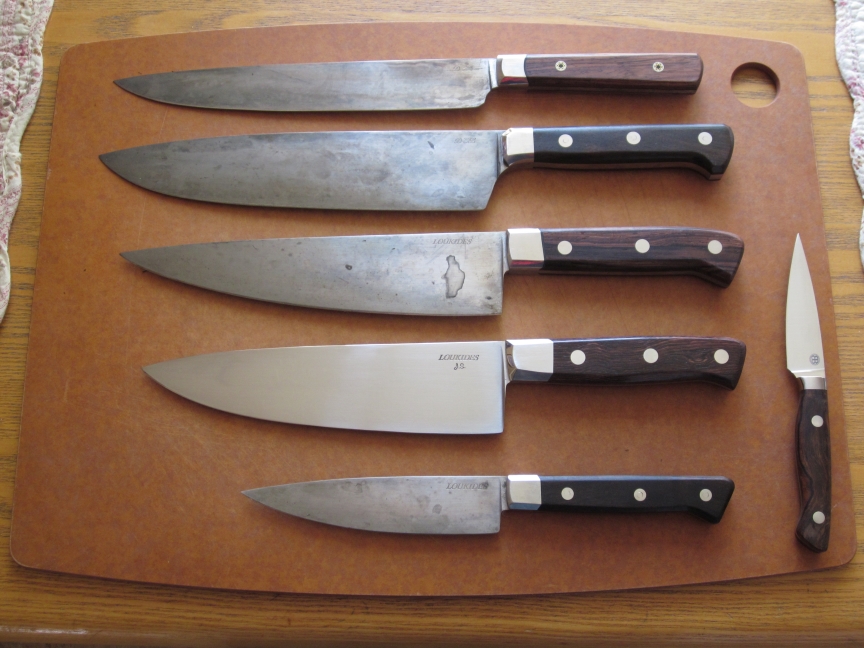
Types of Steel
This photo shows a set of kitchen knives I own; they are by Dave Loukides, with the exception of the paring knife to the right, which was made by Bryan Baker. From top to bottom, I have a 9″ slicer with cocobolo, a heavy German style chef with blackwood, a gyuto with cocobolo, a light German style chef with camatillo, and a petty with blackwood. The parer is ATS34 stainless steel with desert ironwood. The Loukides knives are hand-forged from 1084 steel, hold an edge very well and are extremely easy to resharpen.
As you can tell, staining is prominent and will get darker over time with more use (the second from bottom knife was new when this photo was taken, but is nearly black by now). Some people are very intolerant of this, and I have friends who refuse to use any of my knives because they think the patina is a sign of weakness in the steel. However, I can chop through chicken bones and return the edge to tomato-peeling sharpness with only a few passes on a piece of leather. Stainless steel knives, such as the paring knife shown, easily take four to five times as long to resharpen, and can easily chip or flatten out when used heavily.
With all that said, many people do use stainless steel kitchen knives without issues and probably have never even given a thought to what kind of steel they are made from. Get a decent stainless steel if you don’t want your knives to rust or get spotty, and get in the habit of doing routine maintenance on them before or after each use. You often see chefs honing their knives with a steel rod quite often during their shifts, and the reason is because a dull knife is not easy to sharpen, but a knife that isn’t dull yet has no reason to ever be dull in the first place. A steel rod doesn’t technically sharpen a knife — it simply rolls the edge of the knife back to center position. This isn’t possible if your steel is too hard (harder than the steel rod) or too dull for this to work. Steel can be “too hard” if it is heat-treated poorly (almost never the case when you’re dealing with any reputable maker) or if it is an exotic steel with high vanadium or tungsten content. These “super steels” are sort of the knife world’s version of the latest trend, and they are often highly touted for their edge retention and ability to cut insane materials (steel barrels, concrete) with little or no damage. The trade-off is obvious, you can never sharpen this stuff without specialised tools and a lot of time.
After picking between stainless and carbon steel, you can go even further and pick the exact type of steel. Just like knife styles, knife steels vary widely and there is as much opinion as fact surrounding most of it. Types of carbon steels alone include 5160, 52100, 1080, 1084, 1095, etc. Tool steels include O1, A2, D2, and so on. The numbers often denotes the metallurgy of the steel – 1095 indicates that the steel contains .95% carbon, for instance. I personally use 1084 and 1095 carbon steel knives, partly by choice and partly because that is what the makers I liked were offering. If Dave Loukides forged my chef knives from O1 I would have gladly accepted it, as I know he works well with that steel and I trust him to make something that will do what I need it to.
Joe Calton was kind enough to elaborate on his thoughts regarding steel types:
I only work with three steels. You might say that the steel choice isn’t as important as the relationship that the maker has with the steel choices that he offers. I have seen a lot of makers that will work with any steel that they can get their hands on. I like to work with just the three for now, as I know them really well, as to what they can and can’t do, how thick or thin they need to be for a certain application, and the suppliers that give me the best steel to start with. I only work in high carbon steels, so if someone wants a stainless knife, they should look for a maker that has a good relationship with a stainless steel of their liking. Or when ordering a custom, you could let the maker know what it is that you want the knife to do, and then let them suggest the steel. Picking a maker that has a regular testing schedule {both destructive and regular testing} could help out also. If I wanted a knife in a steel that I don’t work with, this is what I would look for in a maker.
This is sound advice and will keep you from falling into the trap of overanalyzing every type of steel.
Edge
Edge geometry is another factor. The three common geometries are flat ground, convex ground, and hollow (concave) ground. A common grind is a flat grind from the spine to the edge, with a secondary flat grind applied at the edge. Many cleavers have an blade grind that starts close to the edge itself, adding heft and providing a wider bevel for cutting bone and frozen meats. Hollow grinds are more common on blades that are chisel ground, meaning they only have bevels on one side of the blade, leaving the other side perfectly flat. This and other types of asymmetric edge bevels are commonly seen on Japanese style knives. This design emphasises the slicing function of these knives, which can be highly beneficial if you cook seafood, Japanese cuisine, or simply need a very keen slicer. The asymmetry is often specific for right-hand use, so if you are left-handed you will have to let your knifemaker know, or simply stick with a symmetric grind.
Handle
The handle shape on most Western kitchen knives have straight backs and slight curvature in the front. They often consist of slabs of handle material pinned to the sides of the tang, which is commonly exposed but may be hidden as well. Japanese knives often have hidden tangs that fit into a slot in the handle, with the handle being oval or octagonal in shape. The latter is called a wa handle, and this photo of a batch of knives from L.R. Harner illustrates both the wa shape and a variety of woods.
The top knife features curly redwood with copper fittings. The remainder feature blackwood bolsters and, from top to bottom: cherry, purpleheart, buckeye burl, curly koa, and spalted maple. These knives also demonstrate the French profile on a gyuto style knife.
When selecting handle materials, you can choose based on a number of factors, including aesthetic and wear resistance. Synthetic material such as Corian, G10 and micarta are commonly used and, while they may chip if dropped, will literally outlive the steel they are attached to. Natural materials, such as bone, horn, and wood, are also common, with wood being the more common option. Good woods for kitchen knives are hard and dense, such as rosewoods, hard maple, walnut, and ironwoods. It is important that the wood used is “stable,” meaning resistant to moisture and the shrinking, swelling, and warping it causes. Some woods, such as ebony, are naturally dense and oily, so artificial stabilisation is not necessary. Other types of woods, and especially wood burls, are stabilised through a process of vacuum-impregnation with epoxy resin. Most knifemakers buy pre-stabilised wood or know whether stabilisation is needed for the woods they use. If you have a particular type of wood you prefer, you may pay extra for your knife as the maker may not have it on hand and need to order some.
Choosing a Knifemaker
As for choosing a maker, it’s a good idea to go with someone who has made a fair number of kitchen knives already and has thus either acquired knowledge through testing or customer feedback (ideally both). Also, while some makers will happily take orders (you may be on an extensive waiting list, however), some operate with “closed books” and sell on a first come, first served basis. Getting a set from the latter basically entails waiting for a maker to create a set and post it for sale — which may or may not ever happen. If you have custom requests, such as sizes, set pieces, and materials, you will need to find a maker who is willing to work to your specifications.
One way to find makers is to register at one or more of the various forums dedicated to knives. I’ve found bladeforums.com to be hugely informative, and with a large number of users and frequent updates you can usually find a reputable maker who is willing to make you a set of knives without a lot of research. There is another site, kitchenknifeforums.com, which is obviously more specific but doesn’t have nearly the volume of makers using it to sell their wares.
Below are some specific makers I recommend and why.
Calton Cutlery

Joe Calton is presently my go-to guy. Joe’s motto is “performance above all else.” He works only with 1095, 5160, and 52100 carbon steels so he can learn as much as he can about them and squeeze every last drop of performance out of them. Order something in 1095 if you want a knife that is easy to use and maintain — the cleaver and chef shown are made from 1095 with black paper micarta and take every bit of abuse I heap on them without breaking a sweat.
If you want something even more robust, and are willing to pay extra for it, request your knives in 52100 steel. His finish can be a little rough, but he can “pretty up” your knives for an added cost. The rough look is cost effective and, if you’re like me, you probably appreciate it anyway. He is very accommodating to specifications and knows how to make a kitchen knife that does exactly what it is intended to. In other words, if you buy a paring knife and a chef knife from him, you can expect the paring knife to be ground much thinner than the chef.
His prices range from $US50 for a small paring knife to $US140 for a 8″ chef knife. Expect to pay more if you want custom finishes or premium handle materials. He can be reached via caltoncutlery.com.
BRT Bladeworks
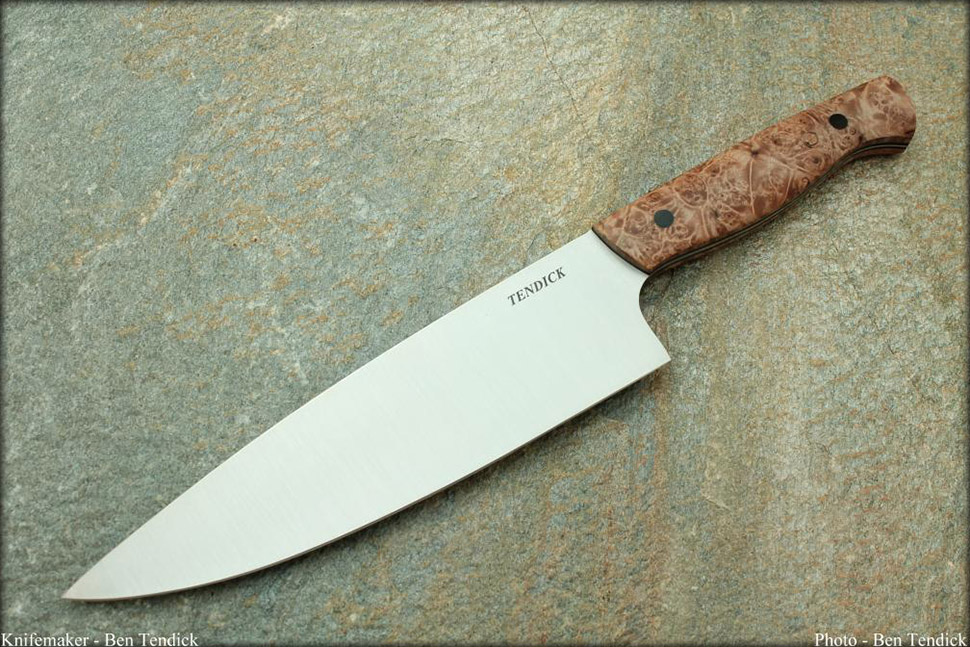
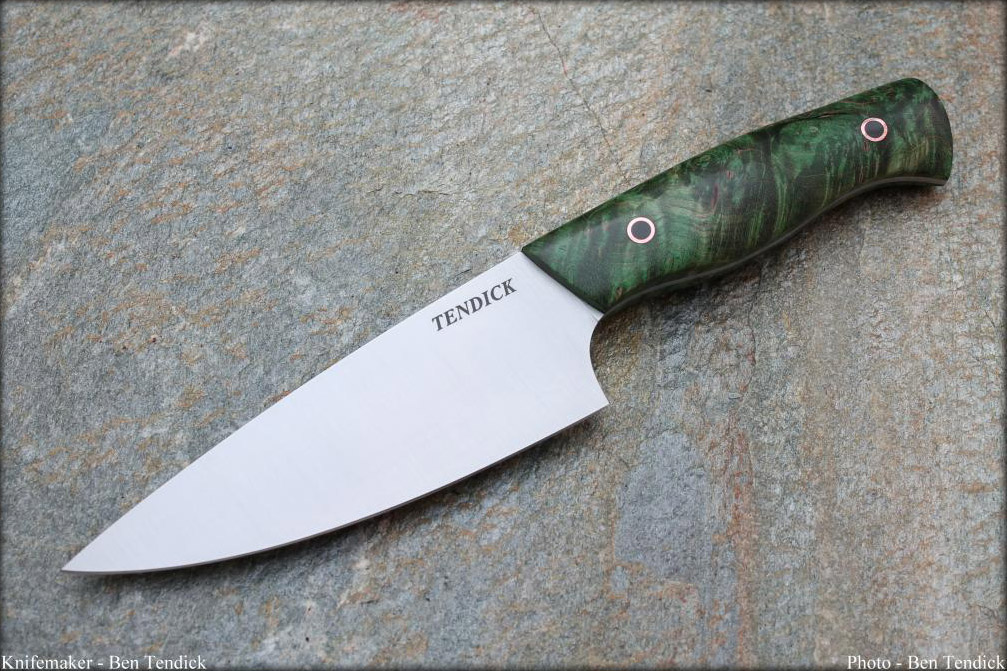
Ben Tendick has been making knives for about four years now, but the cleanness and precision of his work are on par with makers with decades of experience. He primarily makes kitchen knives from 14c28n stainless or 1095 carbon steel, but will work with other steels upon request.
His prices range from $US155 for a basic, carbon steel parer to $US600 for a full size chef with premium stainless steel and exotic handle material. He currently has a wait time of 4-6 months but regularly offers pieces for sale on bladeforums.com. He can be contacted at brtbladeworks.com.
Carter Cutlery
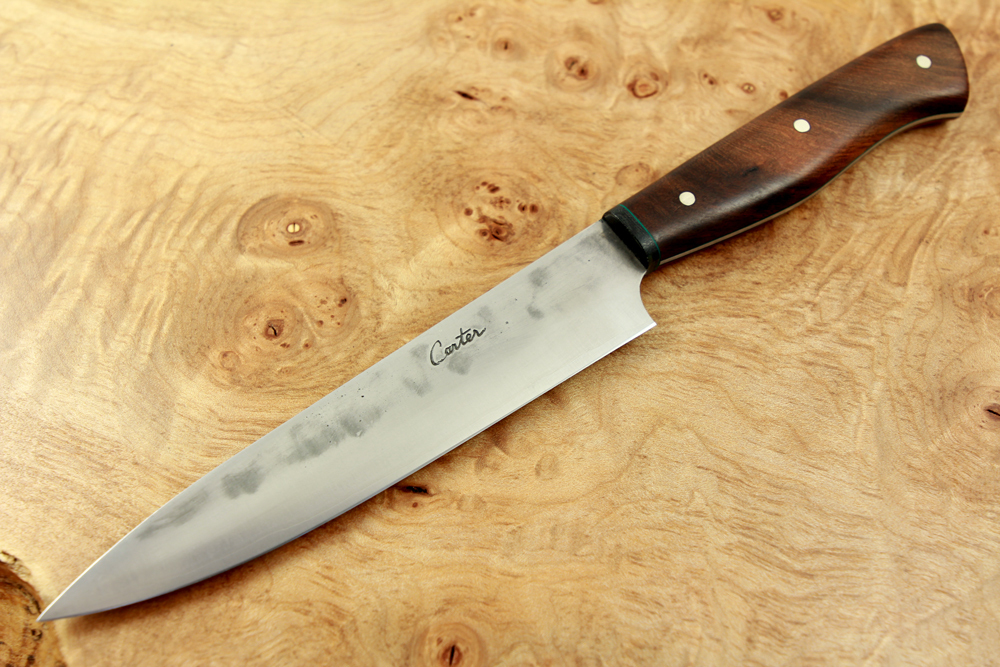
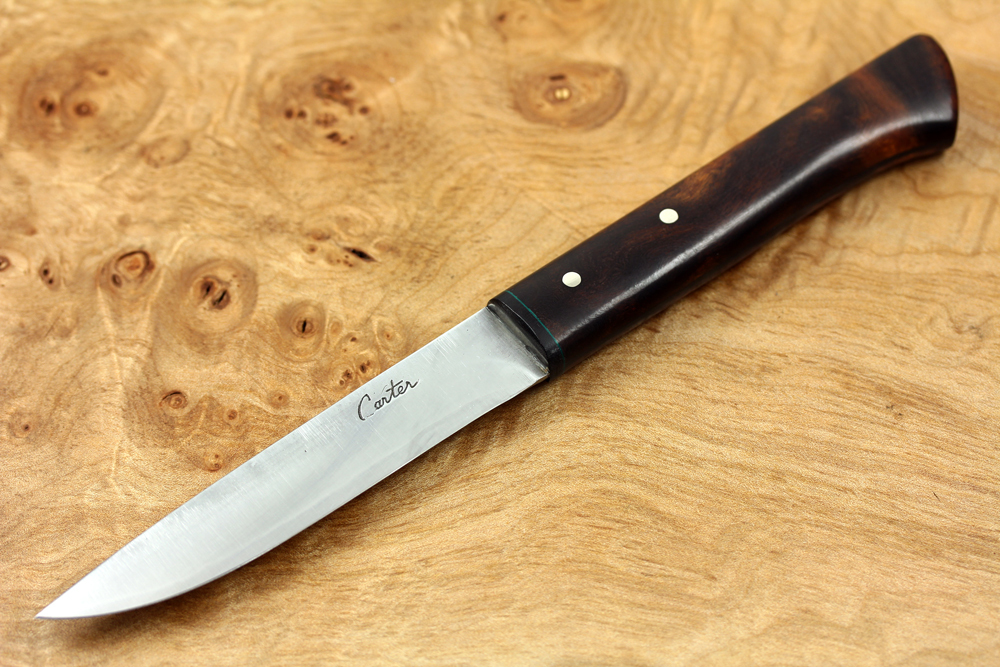
Murray Carter is a 17th generation Yoshimoto bladesmith, meaning he learned the craft in Japan and is the only Caucasian to take such a position. His knives are hand-forged, and he often uses Japanese steels (such as Aogami Super Blue carbon steel) or Japanese methods, such as laminating a carbon steel core with stainless steel sides to get the best of all worlds in terms of cutting ability, ease of maintenance, and stain resistance. Naturally, his knives are also very Japanese styled, but Murray has a style of his own so a lot of what he offers is distinctly different from other makers and common Japanese knife styles.
His prices depend on size and style, with the basic style (Kuro-uchi, or forge-finished) starting around $US1.19/mm and premium styles priced at $US13.71/mm. Here’s a video demonstration of him forging a paring knife:
You can browse Murray’s available pieces or contact him with your custom request via cartercutlery.com.
Harner Knives
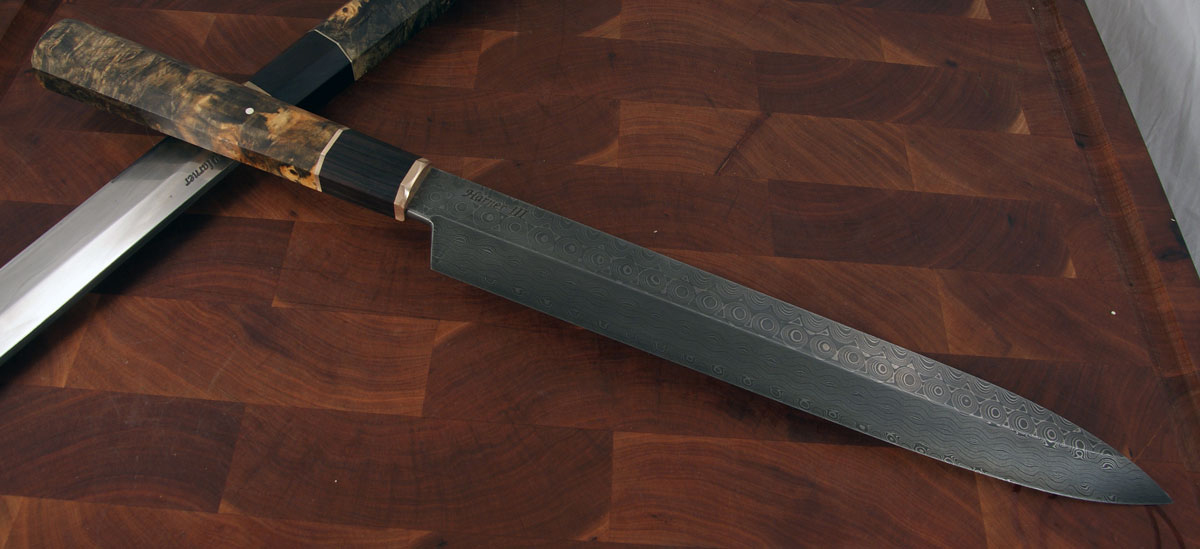

R.L. “Butch” Harner makes some of the most stunning knives I have ever seen. His work is primarily Japanese styled, with wa handles and commonly used profiles such as yanagi and nakiri (top and bottom pictures, respectively). However, his stylistic touches and uses of premium materials such as Chad Nichols damascus and rare, highly figured woods make his pieces highly unique.
His prices range from $US135 for a paring knife to $US2000 for a yanagi. He works with a wide range of steels, from premium stainless to hand-forged carbon. He can be reached online at harnerknives.com.
Bloodroot Blades
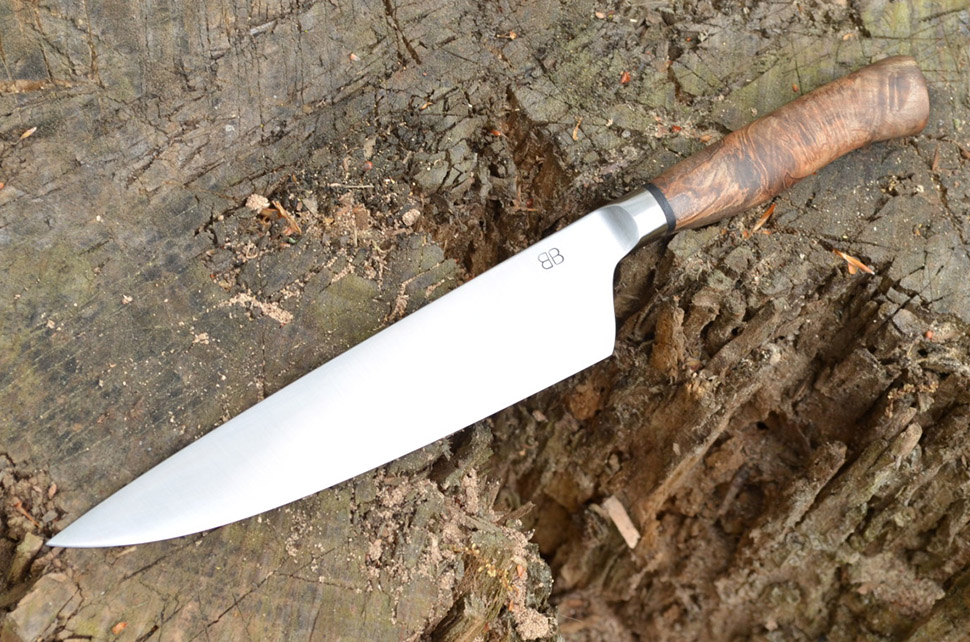

Bloodroot Blades consists of the duo of Luke Snyder and David Van Wyk. They work with a lot of recycled materials, forging automotive leaf springs and lumbermill saw blades into blades for your kitchen. They will also use recycled flooring, reclaimed antler, and laminated burlap bags for handle materials. The resulting knives are clean and beautiful, but with a much more personal flair than your typical custom.
Bloodroot knives are priced between $US175 for a parer up to $US700 for a very fancy chef, with most chef knives ranging between $US400-500. Examples of their work, plus their contact information, can be found at bloodrootblades.com.
HHH Custom Knives


HHH Custom Knives is Randy Haas who has been joined by his son, Randy Jr. They excel at eye-popping damascus steel blades that you might be tempted to put in a glass case, but they are designed for hard use.
An HHH semi-custom gyuto in stainless steel runs $US245, while custom damascus chef knives are $US1,000 and up. Randy can be reached at hhhcustomknives.com.
Wildfire Cutlery
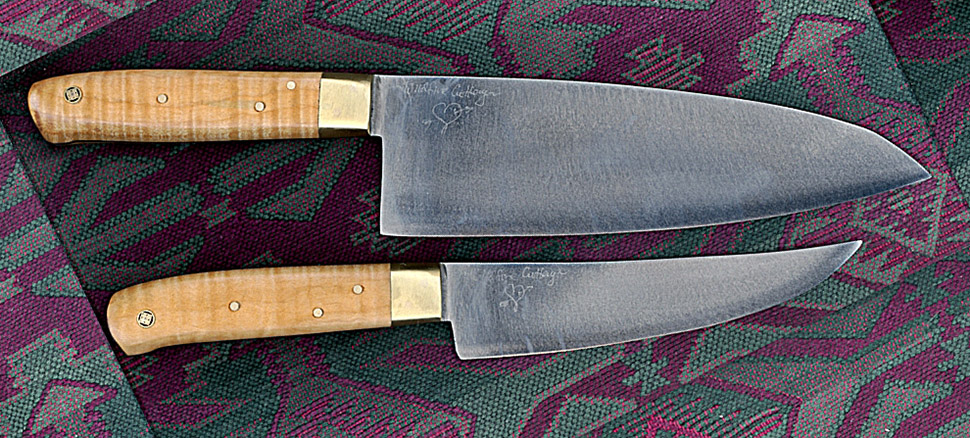
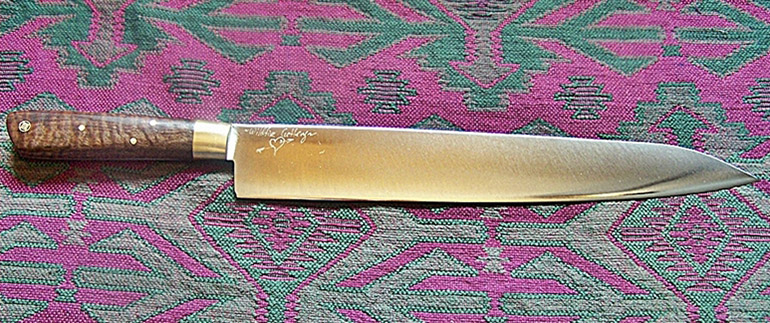
Michael Moses Lishinsky, AKA Wildfire Cutlery, works primarily with 1084 steel, maple and walnut handles, and brass bolsters. He has made kitchen knives of nearly every style imaginable, but all of them with Western style handles and a very personal flair. Of all the makers listed here, Michael is probably the most likely to make you a full set of fully customised knives in almost any style you can imagine.
His prices range between $US76-205 per knife for most styles and sizes. Examples of Michael’s work and a detailed price list can be found at wildfirecutlery.com.
